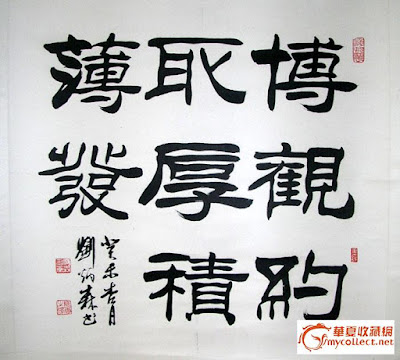Our character today is 声 | 聲. We can see that Simplified version 声 is just the top-left corner of its Traditional version - 聲.
To have a good understanding of the character, we need to work with 聲, which is composed of 声, 殳 and 耳.
We have known that 耳 means ear, and 殳 means "holding a stick". What does 声 mean here? We need to seek help from its ancient scripts, as shown below: (Image taken from http://vividict.com)
To have a good understanding of the character, we need to work with 聲, which is composed of 声, 殳 and 耳.
We have known that 耳 means ear, and 殳 means "holding a stick". What does 声 mean here? We need to seek help from its ancient scripts, as shown below: (Image taken from http://vividict.com)
 |
| evolution history of 声 | 聲 |
From its Oracle Script  , there are four parts:
, there are four parts:  (声),
(声),  (耳),
(耳),  (殳) and
(殳) and  (口). Some linguist claimed that
(口). Some linguist claimed that  is a certain kind of music instrument, which may be made by stones, for
is a certain kind of music instrument, which may be made by stones, for is quite similar to 厂. We have learnt that 厂 is drawing of a stone cliff.
is quite similar to 厂. We have learnt that 厂 is drawing of a stone cliff.
If is a music instrument, then it is a quite reasonable guess that
is a music instrument, then it is a quite reasonable guess that is kind of hanging
is kind of hanging with some strings (
with some strings ( ).
).
Combining and
and  , we will have an image as shown below:
, we will have an image as shown below:
 , there are four parts:
, there are four parts:  (声),
(声),  (耳),
(耳),  (殳) and
(殳) and  (口). Some linguist claimed that
(口). Some linguist claimed that  is a certain kind of music instrument, which may be made by stones, for
is a certain kind of music instrument, which may be made by stones, for is quite similar to 厂. We have learnt that 厂 is drawing of a stone cliff.
is quite similar to 厂. We have learnt that 厂 is drawing of a stone cliff.If
 is a music instrument, then it is a quite reasonable guess that
is a music instrument, then it is a quite reasonable guess that is kind of hanging
is kind of hanging with some strings (
with some strings ( ).
).Combining
 and
and  , we will have an image as shown below:
, we will have an image as shown below: |
| 石罄 |
Now we are clear about what the Oracle Script  represents: hitting (
represents: hitting ( ) a stone music instrument (
) a stone music instrument ( ) while singing (
) while singing (  ) , which is to entertain audiences by hearing (
) , which is to entertain audiences by hearing ( ). Or in short,
). Or in short,  is "listening to musics / songs in a concert".
is "listening to musics / songs in a concert".
Another version of Oracle Script - is simpler: listening (
is simpler: listening ( ) to music instrument (
) to music instrument ( ).
).
 represents: hitting (
represents: hitting ( ) a stone music instrument (
) a stone music instrument ( ) while singing (
) while singing (  ) , which is to entertain audiences by hearing (
) , which is to entertain audiences by hearing ( ). Or in short,
). Or in short,  is "listening to musics / songs in a concert".
is "listening to musics / songs in a concert".Another version of Oracle Script -
 is simpler: listening (
is simpler: listening ( ) to music instrument (
) to music instrument ( ).
).
When it evolved to Seal Script  ,
,  was changed to
was changed to to emphasise the holes in the stone music instrument to differentiate it from normal stones.
to emphasise the holes in the stone music instrument to differentiate it from normal stones.  is already very close to what we have today: 声. And Chinese ancestor considered
is already very close to what we have today: 声. And Chinese ancestor considered  to be a redundant information while representing the meaning of
to be a redundant information while representing the meaning of  . That is why
. That is why  has no longer 口.
has no longer 口.
 ,
,  was changed to
was changed to to emphasise the holes in the stone music instrument to differentiate it from normal stones.
to emphasise the holes in the stone music instrument to differentiate it from normal stones.  is already very close to what we have today: 声. And Chinese ancestor considered
is already very close to what we have today: 声. And Chinese ancestor considered  to be a redundant information while representing the meaning of
to be a redundant information while representing the meaning of  . That is why
. That is why  has no longer 口.
has no longer 口.
That is all. 声 | 聲 thus means sound, or music.
As music are pleasing, when we want to say somebody with good reputation, we use 声 | 聲 to describe that. For example 声名远播.
We have done our learning today, it is now our time to enjoy a Chinese calligraphy with 声 | 聲 inside:
 |
| 诗情画意, 琴韵书声 |


















